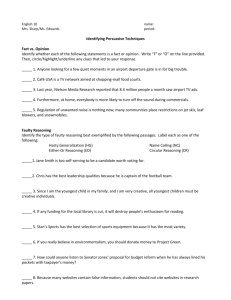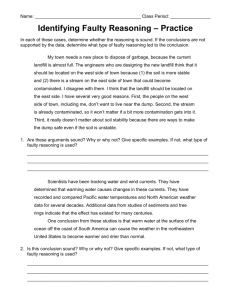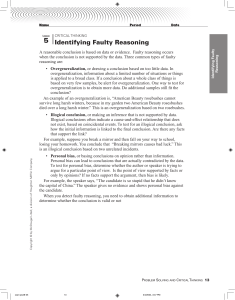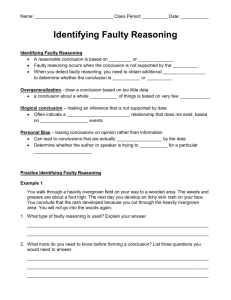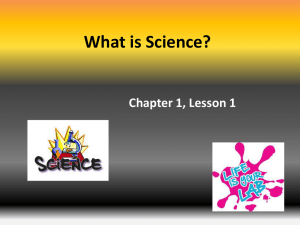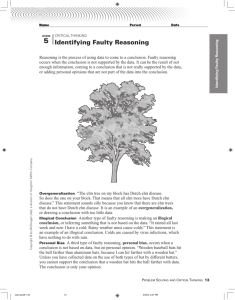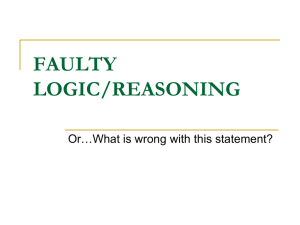Name: :_____Date
advertisement
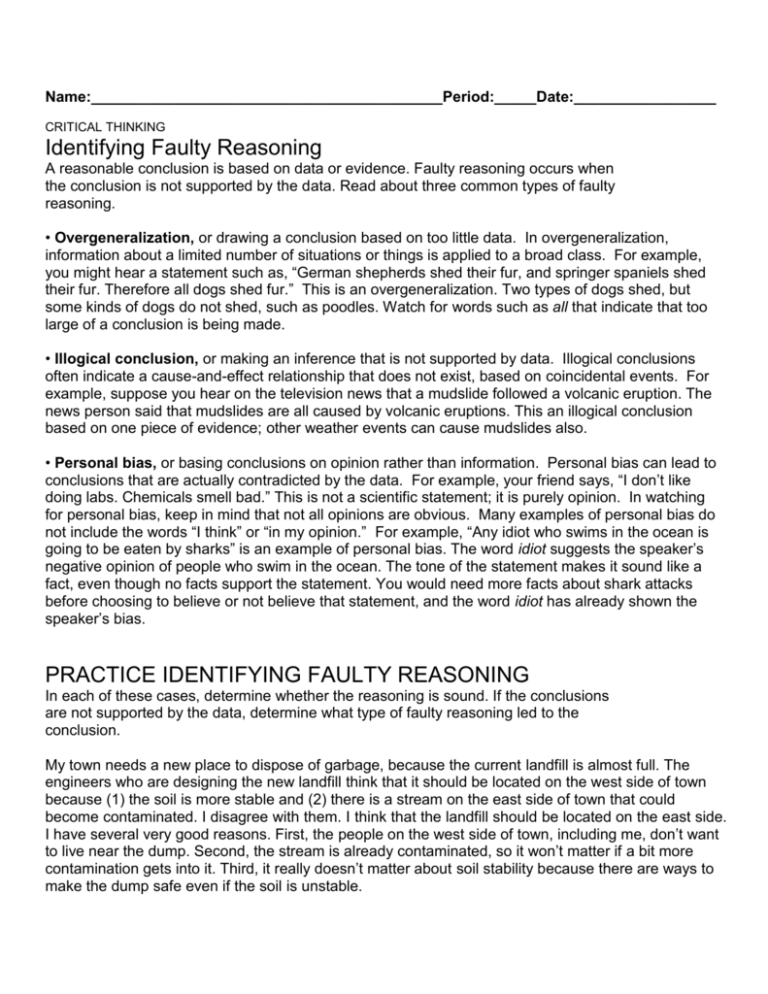
Name:__________________________________________Period:_____Date:_________________ CRITICAL THINKING Identifying Faulty Reasoning A reasonable conclusion is based on data or evidence. Faulty reasoning occurs when the conclusion is not supported by the data. Read about three common types of faulty reasoning. • Overgeneralization, or drawing a conclusion based on too little data. In overgeneralization, information about a limited number of situations or things is applied to a broad class. For example, you might hear a statement such as, “German shepherds shed their fur, and springer spaniels shed their fur. Therefore all dogs shed fur.” This is an overgeneralization. Two types of dogs shed, but some kinds of dogs do not shed, such as poodles. Watch for words such as all that indicate that too large of a conclusion is being made. • Illogical conclusion, or making an inference that is not supported by data. Illogical conclusions often indicate a cause-and-effect relationship that does not exist, based on coincidental events. For example, suppose you hear on the television news that a mudslide followed a volcanic eruption. The news person said that mudslides are all caused by volcanic eruptions. This an illogical conclusion based on one piece of evidence; other weather events can cause mudslides also. • Personal bias, or basing conclusions on opinion rather than information. Personal bias can lead to conclusions that are actually contradicted by the data. For example, your friend says, “I don’t like doing labs. Chemicals smell bad.” This is not a scientific statement; it is purely opinion. In watching for personal bias, keep in mind that not all opinions are obvious. Many examples of personal bias do not include the words “I think” or “in my opinion.” For example, “Any idiot who swims in the ocean is going to be eaten by sharks” is an example of personal bias. The word idiot suggests the speaker’s negative opinion of people who swim in the ocean. The tone of the statement makes it sound like a fact, even though no facts support the statement. You would need more facts about shark attacks before choosing to believe or not believe that statement, and the word idiot has already shown the speaker’s bias. PRACTICE IDENTIFYING FAULTY REASONING In each of these cases, determine whether the reasoning is sound. If the conclusions are not supported by the data, determine what type of faulty reasoning led to the conclusion. My town needs a new place to dispose of garbage, because the current landfill is almost full. The engineers who are designing the new landfill think that it should be located on the west side of town because (1) the soil is more stable and (2) there is a stream on the east side of town that could become contaminated. I disagree with them. I think that the landfill should be located on the east side. I have several very good reasons. First, the people on the west side of town, including me, don’t want to live near the dump. Second, the stream is already contaminated, so it won’t matter if a bit more contamination gets into it. Third, it really doesn’t matter about soil stability because there are ways to make the dump safe even if the soil is unstable. 1. Are these arguments sound? Why or why not? If not, what type of faulty reasoning is used? ________________________________________________________________________________ ________________________________________________________________________________ ________________________________________________________________________________ ________________________________________________________________________________. Scientists have been tracking water and wind currents. They have determined that warming water causes changes in these currents. They have recorded and compared Pacific water temperatures and North American weather data for several decades. Additional data from studies of sediments and tree rings indicate that the effect has existed for many centuries. One conclusion from these studies is that warm water at the surface of the ocean off the coast of South America can cause the weather in the northeastern United States to become warmer and drier than normal. 2. Is this conclusion sound? Why or why not? If not, what type of faulty reasoning is used? ________________________________________________________________________________ ________________________________________________________________________________ ________________________________________________________________________________ ________________________________________________________________________________. You should always avoid walking under a ladder because it brings bad luck. Yesterday, I was cleaning windows and walked underneath the ladder. Later in the day, I spilled milk on the living room carpet. Then I lost my homework and had to start over. As I was starting to work again, the bulb in my reading lamp burned out. You can be sure that I won’t walk under ladders again. 3. Are these good reasons to not walk under ladders? If not, what type of faulty reasoning is used? ________________________________________________________________________________ ________________________________________________________________________________ ________________________________________________________________________________ ________________________________________________________________________________. Fish live and swim in the ocean. They have fins and long streamlined bodies. Many kinds of fish eat smaller fish and other animals. Because this description applies to all of the animals in the illustration, they can all be classified as fish. 4. Is this an example of sound reasoning? Why or why not? If not, what type of faulty reasoning is used? ________________________________________________________________________________ ________________________________________________________________________________ ________________________________________________________________________________ ________________________________________________________________________________.
